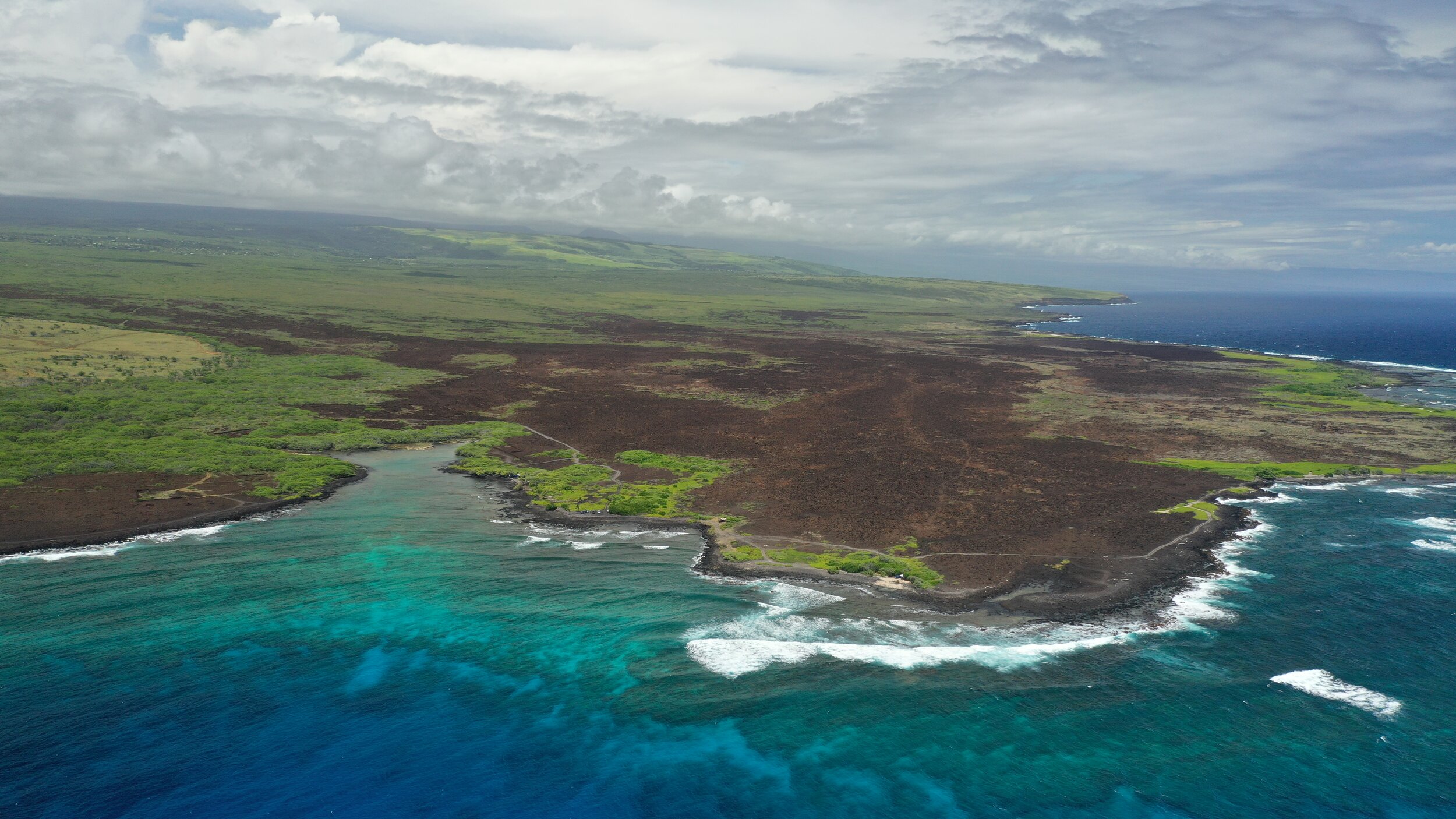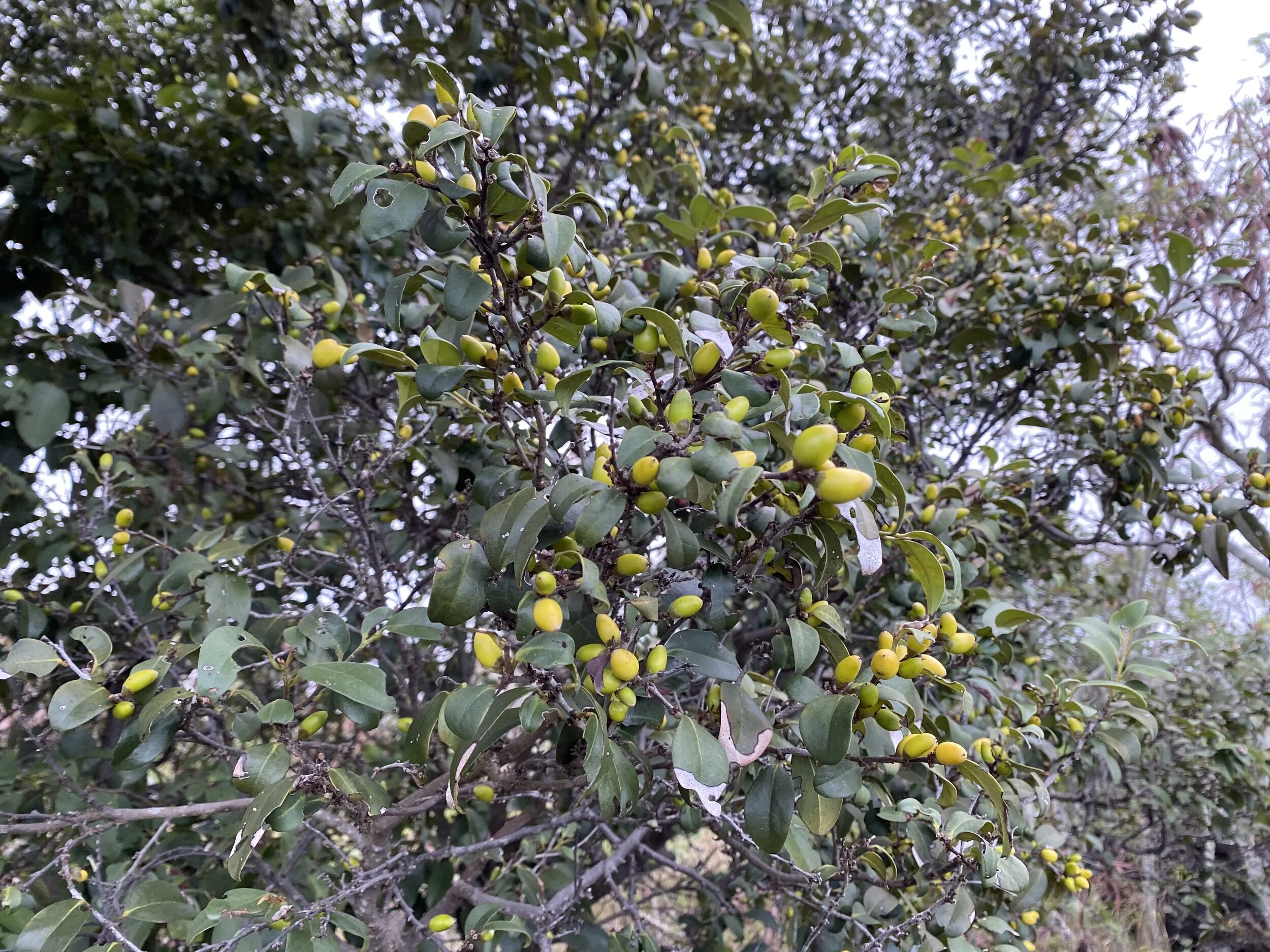Kiolakaʻa at Kaʻaluʻalu bay
Photo Credit: Shalan Crysdale, The Nature Conservancy
Kiolaka‘a is south of Waiʻōhinu Town, moku of Ka‘ū, Hawai‘i Island. The land is home to treasured natural and cultural resources including portions of the ancient Kamakalepo settlement, Lua Nunu cave system, heiau, habitation sites, intact native dryland forest, an extensive trail network, native coastal plants, Kapenako spring, anchialine ponds and the eastern shoreline of Ka‘alu‘alu Bay.
“Kau ʻino no waʻa o Kaʻaluʻalu.
The canoes hasten ashore at Kaʻaluʻalu.”
Ka‘alu‘alu Bay is a rich marine ecosystem. In ancient times, the bay was an important landing for canoes and also a famous surfing spot. Its surrounding waters and fishpond provided an abundance of marine resources. During the plantation era, the lands were used to pasture cattle and goats starting with Ka‘alu‘alu Ranch owned by Princess Ruth Ke‘elikōlani. Ka‘alu‘alu was once the main port in Ka‘ū for the import of goods and export of cattle. Today, Ka‘alu‘alu is a popular beach accessed by the community for fishing, surfing, and camping.
a thriving ecosystem
Tropical dry forests are among the most threatened ecosystems on a global scale, with less than 10% and arguably less than 5% of intact tropical dry forest remaining throughout the world.
Ēlama or Lama was the dominant tree species of a once thriving tropical dry forest region, with which the Wao Lama (Lama Realm) was named.
With nearly half of the native ecosystems converted to non-native conditions, less than ten percent of the dry forests remain to date with over 25% of the federally listed endangered Native Hawaiian plant species deriving from dry forests or dry scrub habitats. Hawaiian tropical dry forests are susceptible to high levels of invasion by non-native species, extreme water limitation and Hawaiian endemic species extinction. Invasion of grasses and subsequent fires are responsible for 90% of the Hawaiʻi tropical dry forest destruction to date. Other threats to this native ecosystem are feral ungulates and increasing development.
Wiliwili are deciduous trees, shedding their leaves annually just before blooming.
At Kiolakaʻa, an intact tropical dry forest area remains. Endemic and indigenous species must be protected and stewarded in partnership with other forest conservation organizations. Native vegetation located within the vicinity include Wiliwili (Erythrina sandwicensis), ʻUhaloa (Waltheria indica), Maiapilo (Capparis Sandwichiana), ʻŪlei (Osteomeles anthyllidifolia), ʻIlieʻe (Plumbago zeylanica), and Huehue (Cocculus orbiculatus).
Kapenako, a pristine fresh water spring located at the hub of a series of ancient trails, is a part of a complex of six pools that come and go with the tides. The pools are teeming with two varieties of ʻōpae ʻula, Metabetaeus lohena and Halocaridina rubra (nominated for threatened status).
Aerial of Kaʻaluʻalu c. 1941; the trail traverses across a loko iʻa wall at the mouth of Kaʻaluʻalu bay.
Protecting Kiolaka‘a would maintain miles of open space and public access to the coastal lands surrounding Ka‘alu‘alu Bay. It would also preserve the ancient Kamakalepo settlement and Lua Nunu cave system, the most extensive refuge cave on Hawai‘i Island used to defend Ka‘ū during the wars with Kamehameha.
The Ka‘ū community has been working for years to protect their beloved 80 mile coast to honor their kūpuna (ancestors) and empower future generations to perpetuate their rural lifestyle and Hawaiian culture. Conserving this landscape will perpetuate cultural access for descendants and recreational access for travelers along the ancient ala loa (Ala Kahakai Trail) allowing all to walk in the footsteps of Ka‘ū’s ancestors.
Conservation Funding
On April 23, 2021 the State BLNR approved a recommendation by the State Legacy Land Conservation Commission to grant an award for the preservation of Kiolakaʻa at Kaʻaluʻalu Bay.
Protection of the Ka‘ū coastline has been a long-standing goal of the community. With only a handful of privately owned properties at risk of development, this vision of protecting the entire Ka‘ū coastline can be achieved. A preservation purchase would protect this beautiful stretch of coastline which has been threatened by development interests for many years. Kiolakaʻa has been targeted for a large scale subdivision that would impact numerous cultural sites throughout the landscape as well as sensitive native plant habitat, open space and public access.
Photo Credit: Shalan Crysdale, The Nature Conservancy






